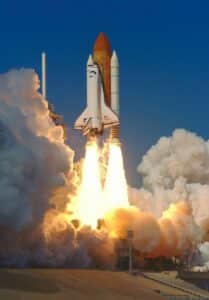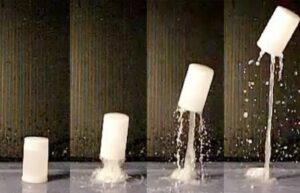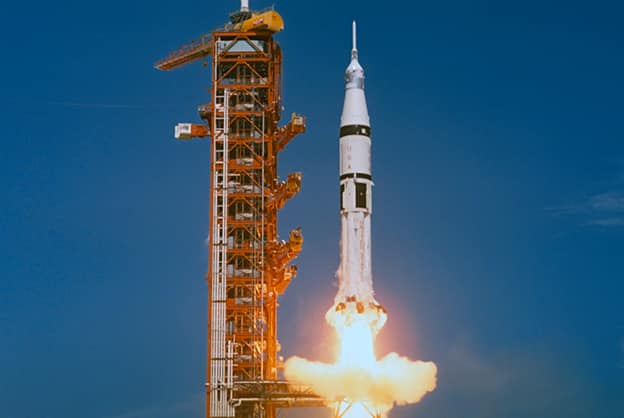Overview
STEM careers
Time
Materials
Per Whole Group:
|
Per Team:
|
Relevant Terminology
Acid: For older kids and adults: A substance that produces hydrogen (H+) ions in water. Common examples include citric acid (lemons and oranges), acetic acid (vinegar), and carbonic acid (soft drinks).
Base: For older kids and adults: A substance that produces hydroxide (OH-) ions in water. Common examples include soaps, oven cleaners, and Tums or other antacid medicines.
Payload: Something a rocket brings into space, such as astronauts, supplies, or equipment.
Rocket: Something shaped like a cylinder that can be shot very far or high by using combustion to make it go.
Thrust: A force that acts backward away from the rocket. As the force thrusts one way, the rocket shoots the other.
Introduce

Twin columns of flame flow from the solid rocket boosters as the space shuttle Endeavour roars into space. Credit: NASA
GETTING READY
Open the Alka-Seltzer tablets and break them into fourths.
Tape each target to the wall and place a table 8 feet away from it. Place a plastic tray on the table; this is the launch pad. If possible, rope off the area between the launch pad and the targets to prevent people walking through the path of a rocket.
INTRODUCTION
Have you ever seen a rocket launch? How does it look different than when a plane takes off? (Rocket engines, like those used by NASA, burn fuel to create hot gas. As this gas is ejected out of the bottom of the engine, the rocket accelerates in the opposite direction.)
What are some uses of rockets, other than exploring space? (Fireworks, model rocketry, military.)
Instructions
Introduce the design challenge. Participants will build a small rocket that can carry a payload of clay to a target several feet away. Each rocket will consist of a film canister, Alka-Seltzer, and water.
Provide instructions to the participants:
Work in small groups to design your rocket.
- Where should the clay be placed on your rocket? (Hint: Payloads being sent to space are placed at the nose of the rocket. This increases stability and allows parts of the rocket to break away to reduce mass.)
- How much water and Alka-Seltzer should be used?
- How will the rocket cover the horizontal distance to the target?

Time-lapse image of a film canister rocket taking flight. Credit: Dean R. Wheeler, Brigham Young University.
Build your rocket.
- Place your clay payload on the outside of the canister.
- Remove the cap and pour your desired amount of water into the canister.
- Place the Alka-Seltzer in the rocket, replace the cap, and quickly place the rocket cap-side down on the launch pad. (You can sandwich the Alka- Seltzer between the lid and a sheet of toilet paper, thereby keeping the Alka-Seltzer up by the lid instead of submerged in the water. This will prevent the chemical reaction from starting until the instant you flip your rocket over.)
Wait for the carbon dioxide to build up in your rocket. It may take a moment for enough pressure to build up. Watch your rocket’s flight. What do you need to change in order to hit the target?
Evaluate the success of each design.
- Did the rocket have enough thrust to reach the target?
- Did the rocket fly accurately enough to hit the target?
ACTIVITY VARIATIONS
Create a worksheet to keep track of variables that were changed with each new design. Weigh the Alka-Seltzer, water, and clay each time and compare the flight results.
Younger children may be content to just watch their rocket launch vertically. Experiment with different amounts of water and Alka-Seltzer and watch how it changes the height of the flight.
Try using seltzer water, soda, or hot water and compare the results to determine if the type of liquid affects the height or distance traveled by the Alka-Seltzer rocket.
TROUBLESHOOTING
Some rockets may fail to launch. This could be an issue of not enough fuel, or residue from multiple launches might cause the lid to fit too tightly. If you think there was enough fuel, clean the canister and try again.
Guiding questions
GUIDANCE FOR YOUNGER CHILDREN
QUESTIONS TO ASK AFTER THE ACTIVITY
- How much water did you use in your Alka-Seltzer rocket?
- How much Alka-Seltzer did you use in your Alka-Seltzer rocket?
- Did the rocket take off right away? What do you think caused any delay?
- Where you able to hit the target? Why or why not?
- If you did not hit the target on the first try, what changes did you make to your design to make it more likely to hit the target?
GUIDANCE FOR OLDER YOUTH AND ADULTS
QUESTIONS TO ASK AFTER THE ACTIVITY
- Were you able to hit the target? Why or why not?
- How did you determine how much Alka-Seltzer and how much water to use in your Alka-Seltzer rocket?
- Did you experiment with different quantities of Alka-Seltzer pieces, and if so, what did you discover?
- What challenges did you face while designing and testing your rocket, and how did you overcome these challenges?
Engineering & science connections
GUIDANCE FOR YOUNGER CHILDREN
Engineering Connections
Engineers create rocket engines to lift rockets, astronauts, and satellites into space. As with your rocket, sometimes the power for these engines comes from reactions that happen when you mix two substances together. In the 1960s, engineers designed the Saturn V rocket. Its engine used a reaction between rocket fuel and oxygen. When mixed together, the fuel and oxygen provided the power to lift the rocket into space and deliver the astronauts to the moon for the first time.
To get such a big spaceship all the way to the moon, the Saturn V rocket had to generate a tremendous amount of power. To this day, it still holds the record for the engine able to carry the greatest capacity into space: 310,000 pounds. That’s enough power to lift 200 elephants into space!
Science Connections
Sometimes when different substances come in contact with one another, they produce what is called a chemical reaction. A chemical reaction happens when two or more substances mix to make something new. If you have ever made a volcano in your kitchen with baking soda and vinegar, you have seen a chemical reaction. Chemical reactions can occur in nature, or they can be started by people.
Alka-Seltzer tablets are made up of two types of substances: one type called an acid and another type called a base. When these tablets are mixed with water, a chemical reaction happens. The reaction produces bubbles of a gas called carbon dioxide. The pressure inside the rocket increases as more bubbles form, until the lid pops off—just like blowing up a balloon so much that it pops.
GUIDANCE FOR OLDER YOUTH AND ADULTS
Engineering Connections
What would happen if your rocket took off before you wanted it to? What if it happened with a real rocket with real people on board? The result would be disastrous. In order to control exactly when a rocket launches, engineers design systems to make sure that the chemical reactions that provide the power for liftoff only happen exactly when they want them to. In liquid-powered rocket engines, rocket fuel and oxygen are stored in separate compartments so that they do not come in contact with each other. Only when the rocket’s pilot is ready does he or she allow the two substances to mix. This is done by releasing the substances into a combustion chamber at the bottom of the rocket where they burn to produce pressurized hot gases.
Science Connections
Real rockets use the same principles as your Alka-Seltzer rocket to overcome the force of gravity and launch into space. Isaac Newton’s Third Law of Motion states that for every action, there is an equal and opposite reaction. The chemical reaction in the rocket’s engine produces the force called thrust that acts backward away from the rocket. This is the action that Newton is talking about. As a result of this force acting backward, the rocket is pushed in the opposite direction. This is the reaction. Since the reaction force is stronger than the force of gravity on the rocket, the rocket can blast off to space.
Activity adapted from Cincinnati Museum Center. All rights reserved.
Supplemental content adapted for Dream Big Activities by Carnegie Science Center.


0 Comments